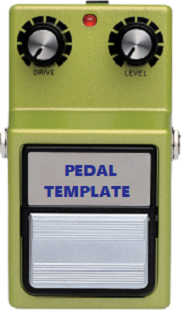Arcadiator
Rullywow Arcadiator. The Arcadiator is categorized by its creator as an "Octave Fuzz", but might best be described as a pedal that has a penchant for converting your instrument signal into the 8-bit video games sounds from the "Golden Age of Video Games". It was actually invented by Fredrik Lyxzen of Parasit Studio, but the PCB, when we got it, was offered by Rullywow. Rullywow's offering was made available by a friendly agreement between Ben at Rullywow and Fredrik until such time as Fredrik at Parasit Studio began fabricating and selling the PCBs himself.
As you can probably imagine, Rullywow no longer makes the PCB for the Arcadiator.
- Thermionic Studios has one(1) original Arcadiator by Rullywow. When we finish assembling it, it will be available for rental
Controls

- Switch 1 - "Mode": This switch toggles the pedal between up ("On"), and down, ("alternating dry note/octave-down note")
- Knob 1 - "Level": Adjusts the output volume with fully clockwise being maximum
- Switch 2 - "PWM": This switch controls between up ("Octave Up") and down ("Pulse Width Modulation")
- Knob 2 - "Width": Adjusts the Width of the Pulse Width Modulation with fully clockwise being maximum
- Switch 3 - "LFO": This switch toggles the low-frequency oscillator between up ("Alt"), middle ("Off"), and down ("Chop")
- Knob 3 - "Rate": Adjusts the control3 feature with fully clockwise being maximum
- Switch 4 - "Octave": This switch toggles the Octave feature between up (one octave down), middle (both octaves), or down (two octaves down)
- Knob 4 - "Blend": Blends the Octave feature between no octave and, fully clockwise, only octave.
- Footswitch 1 - "On/Off": This footswitch toggles the pedal between engaged/active ("On"), and bypassed ("Off")
Controls Guidance
- General: Volume around 12:00 is usually close to unity. Depending on the blend setting, there may be slight dips or boost to the overall loudness of the sound. Use Volume to compensate. Suggested initial toggle settings: Mode down (octave off), LFO down (off), and Octave down (1 oct down)
- Fuzz: Turn blend fully CCW, 100% Fuzz. Octave is off so you can’t hear that anyways. Set this way the Arcadiator is a bit crushy fuzz. Play around with the Width knob and the PWM/Octup toggle to hear the range of Fuzz tones. The fuzz will work with chords and needs no special playing technique.
- Octave: Toggle Mode up (octave on) to activate the octave. Leave the Octave toggle down (1oct down) for now. Turn the blend CW, you’ll hear the octave introduced to the sound.
- Analog octavers require playing in a certain manner in order to track well. The circuit needs to hear the fundamental tone of the note you are playing. Tips: use neck pickup, play nearer the neck than the bridge, palm mute a little bit to make precise notes and kill higher harmonics. Toggle Octave up (2 oct down). Now you’ve got 2 octaves down. If you’re using bass, this is way lower than is useful, but sounds great on guitar or high up on bass. Play around blending some fuzz with 1 or 2 octaves down. Try blending octave up fuzz with 2 octaves down, or wide PWM fuzz with one octave down. Lots of different sounds.
- LFO: LFO activates secondary octave and cycles between primary and secondary octaves with adjustable rate. If mode is off, only secondary octave is heard. Toggle LFO up to activate. LFO is only active when triggered by signal from instrument.
- With a low Rate, LFO can produce rhythmic arpeggio-like basslines. With a high rate, a warbly video game sound can be produced. The LFO functions best with the Octave toggle down. Toggling Octave up makes the lower octave (2 down) primary and the higher octave (1 down) secondary. Tracking is sometimes more difficult this way; try turning the Width knob CW as this seems to help. Depending on the frequency resolution of your instrument, sometimes using Octup fuzz with LFO makes the lowest note a fifth lower instead of a full octave lower.
Bypass: True
The Rullywow Arcadiator is true bypass.
General Information
This pedal is not unlike most other analog pitch-shifting pedals, and while chords can be played, your best results are likely going to come from playing one note at a time. That said, there are instances when chords are played that can sound pretty good.
This is not a "pretty sounding" pedal, but it is very distinctive. This circuit also has the potential a lot of gating. It's very easy to make the same kind of "farting" sounds on this pedal that you'll find available in other very heavily gated fuzz pedals. It's not a "bad" thing or a "good" thing: more of an "is" thing, presuming this is the kind of sound you're looking for.
Pedal Manual
Phase Inversion: Yes/No
Schematic
Artists
We are currently unaware of any artists actively using the pedal now, or who have in the past.
- Additional Sources